The question of how to insulate a private house can arise in two cases: the first - at the stage of designing a new house, the second - when an already built house is purchased, which requires significant improvements in order to be comfortable for living. Within the framework of this article, we will tell you what kind of thermal insulation material can be chosen for a particular structure, where to start insulation, how to insulate all structural parts of the house.
Thermal insulation materials for a private house
The modern market is saturated with various thermal insulation materials. When choosing what material to insulate a private house with your own hands, pay attention to the following characteristics:
- Coefficient of thermal conductivity(hereinafter simply "λ", W / (m · K)). The lower it is, the better. More precisely - the smaller the layer of this insulation will have to be used.
- Water absorption coefficient(% by mass). Shows how much moisture can be absorbed by the material. Accordingly, the higher this indicator, the more likely it is that in some structures this insulation will lose its properties in a short time. The lower this indicator, the better.
- Density(kg / m3). Shows the weight of the insulation, this allows you to calculate how much it weighs the structure and whether it is capable of withstanding such a weight.
- Flammability class... There are classes from G1 to G4. For insulation of residential premises, it is better to use materials of class G1, they stop burning without a source of open fire.
- Environmental friendliness... In fact, this parameter may not be important for some. But if you care about your health and the health of your family, then you can try to choose the most natural material that does not emit any substances into the air and does not contain synthetic impurities or binders.
- Durability material.
- Steam flow capacity.
- Complexity of installation.
- Soundproofing ability.
Inorganic raw materials
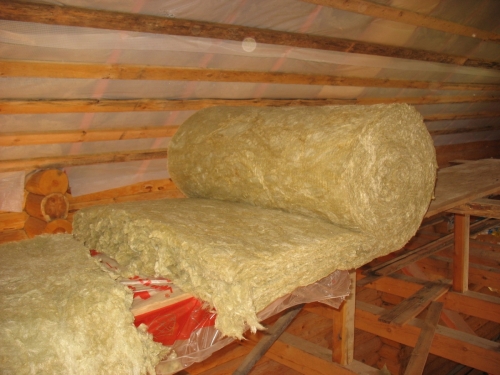
(λ = 0.041 - 0.044 W / (m · K)) is a fibrous material similar to cotton wool obtained from various rocks or slags. According to the form of release, it can be in rolls or plates. There are also products of various densities, from 20 kg / m3 to 200 kg / m3. This allows you to choose exactly the type of cotton wool that is needed in a given situation.
In addition, any cotton wool dampens air noise well and has amazing soundproofing characteristics, in addition it is vapor-permeable ("breathes"). It does not burn, but rodents can start in it.
The main and main disadvantage of any wool as a heater is that it is capable of absorbing up to 70% moisture. And besides, having already absorbed 2%, it loses 50% of its insulating properties and will never dry out completely, using it to insulate external structures: an unprotected facade or roof is just madness.
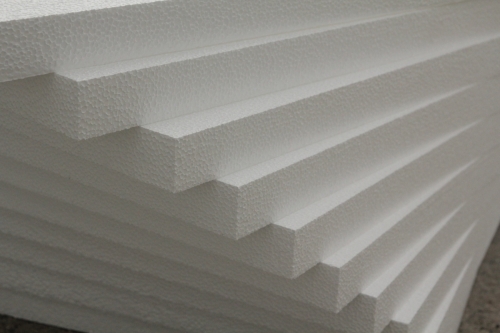
Expanded polystyrene or Styrofoam(λ = 0.033 - 0.037 W / (m To obtain such a gas-filled plastic, thermoforming is used. This material is produced only in slabs, but it comes in different densities, from 11 to 35 kg / m3. Polyfoam is a fragile material, does not withstand heavy loads, burns, while emitting toxic gases, and is also destroyed by sunlight.
Despite the fact that the foam insulates well, while gaining little moisture, it also has a significant drawback: it does not "breathe", which means that a serious supply and exhaust ventilation system will have to be installed in the house. Also, polystyrene foam still gains moisture when it gets wet directly. In this case, it becomes completely unusable for further use.
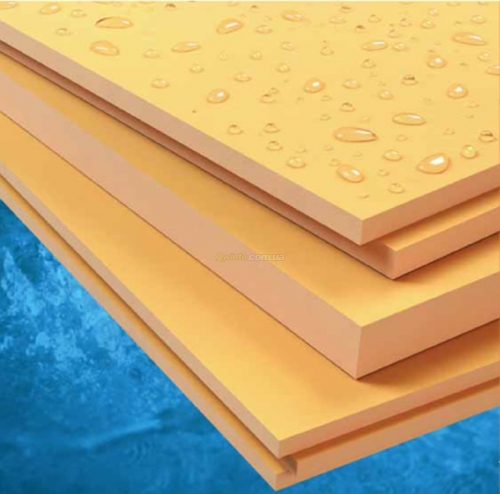
Or EPPS(λ = 0.028 - 0.032 W / (m · K)) - closed polystyrene cells with air. This material practically does not absorb moisture and does not allow air to pass through. It is produced in plates that are convenient for installation. The main advantage of extruded polystyrene foam in relation to foam is greater strength. At the same time, he also "does not breathe", burns and emits toxic gases.
Important! Manufacturers claim that some brands of polystyrene and extruded polystyrene foam do not emit any substances even when smoldering or burning, in practice this is not entirely true.
Here we have considered the most popular materials that are recommended primarily by all experts in the insulation of private houses. If you are not satisfied with the prospect of living in a modern synthetic thermos, you can consider the other materials below.
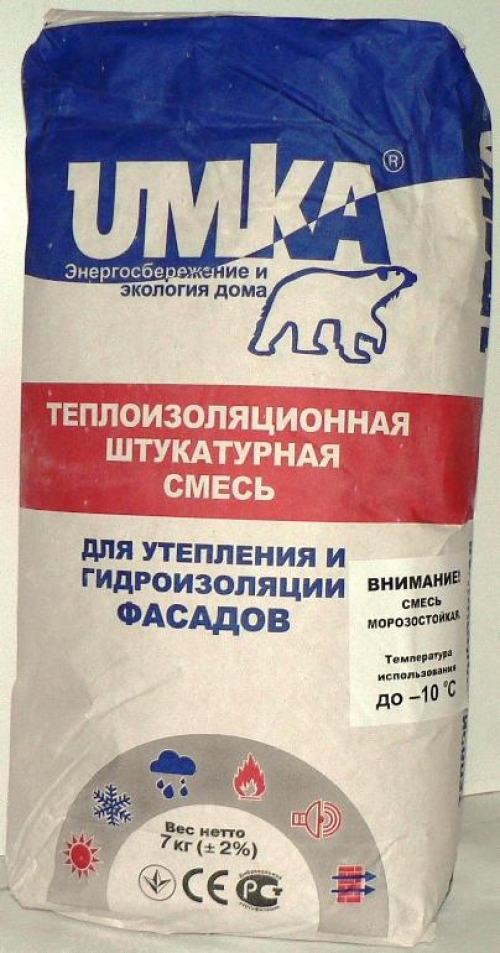
"Warm" plasters(λ = 0.065W / (m Foamed glass balls give the mixture increased thermal insulation properties.
"Warm" plasters "breathe", do not allow moisture to pass through (serve as waterproofing), do not burn.
In fact, this material immediately serves as sound insulation, thermal insulation, waterproofing, while it is not afraid of sunlight, fire, moisture (does not pass), vapor permeable, and can be repaired.
Organic materials - natural

(λ = 0.045 - 0.06 W / (m · K)) are made from the bark of cork oak (solid wood) or recycled cork chips. The principle of manufacturing is as follows: the cork crushed to a state of powder is processed under high pressure with hot steam, then pressed in molds using a binder - natural resin, after hardening, it remains only to cut into plates.
The cork "breathes", i.e. allows air to pass through, mold and other fungi do not form on it, but it ignites. True, it does not emit any toxic substances during combustion.
Cork insulation can be used to cover roofs, ceilings, exterior and interior walls and floors.
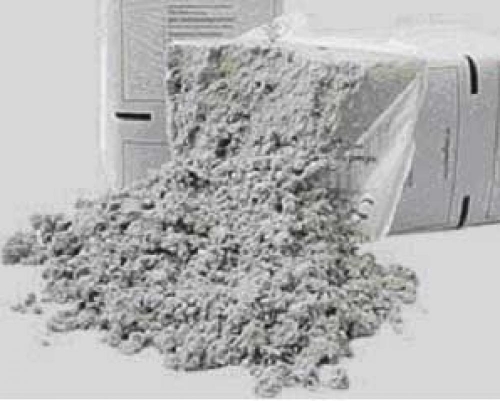
Ecowool or cellulose wool(λ = 0,032 - 0,038 W / (m
Cellulose insulation “breathes”, is resistant to the formation of mold or other fungi, but absorbs moisture well, which means that it requires protection from water. The material in the form of cotton wool does not withstand mechanical stress, so it makes sense to use it for insulating attics. Also, hard insulation is made from paper, but with the addition of binders.
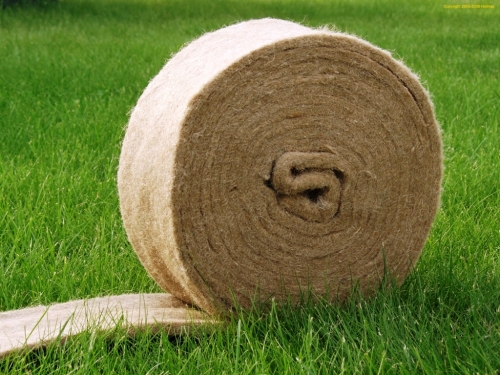
(λ = 0.04 - 0.05 W / (m The form of release is different: mats, plates, rolls, individual fibers that can be used to seal cracks. To reduce the fire hazard, boron salts are added to the material. Despite the fact that the density of the material is 20 - 68 kg / m3, hemp does not withstand pressure loads poorly.
Hemp "breathes", is not afraid of fungus, it is used to insulate roofs, ceilings, facades and walls.
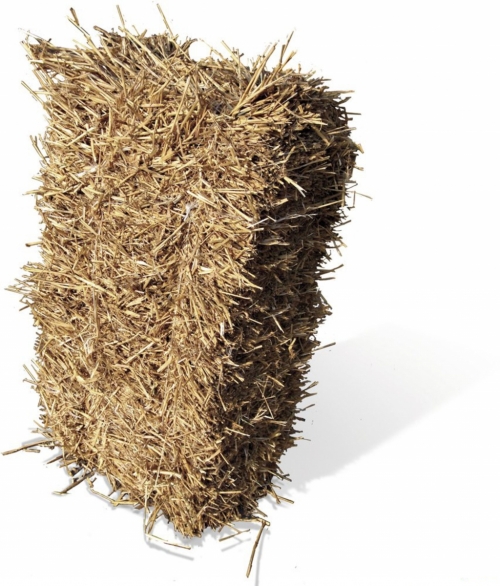
Straw(λ = 0.038 - 0.072 W / (m Straw of rye, wheat, barley, oats is used as a material. It is pressed and tied with a net, wire or cords. The density of straw heaters is 90 - 125 kg / m3, they can be plastered on top.
The straw "breathes", but it also burns well. Therefore, sometimes it is treated with fire retardants.
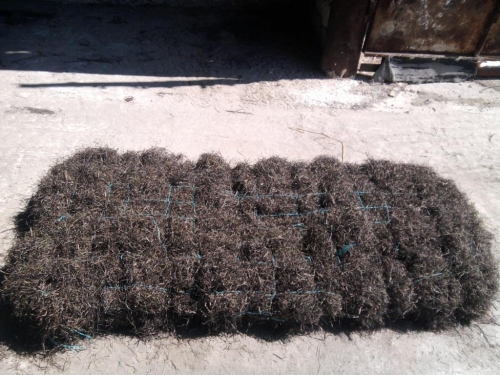
Seaweed(λ = 0.045 - 0.046 W / (m Thanks to sea salt, algae are not afraid of fungi and other mold. Density 70 - 80 kg / m3.
Algae ladders do not burn, do not rot, mold and large animals (mice) do not start in them. Wooden beams, rafters or planks located under the algae are always kept dry, so they serve for a long time. Algae are used to insulate roofs, ceilings and walls.
What is the best way to insulate a private house from the outside
We would like to clarify right away that the insulation of a private house is best done from top to bottom, i.e. start with the roof, then the attic, walls, floor and foundation. But for convenience, we will divide all work into external and internal. Insulation of the house from the outside consists in insulating the walls of the foundation and basement, as well as the front walls. Please note that the material and its required thickness should be calculated, for this you can contact the design offices.
How to insulate the foundation of a private house
Significant heat loss occurs through the foundation. This is due to the fact that the walls of the foundation are in direct contact with the ground and backfill, which freeze to a certain depth.
Due to the fact that the walls of the foundation are constantly in contact with water, it is necessary to select hydrophobic materials for their insulation.
Suitable: extruded polystyrene foam (EPS), foamed glass,adobe(clay with straw), red brick with floor(burnt, with air bubbles inside).

EPS insulation or foamed glass must be fixed to the foundation wall with adhesive mastic. Necessarily to the depth of soil freezing. From above, these materials do not need to be protected from the ground, and in the basement part, they can be covered with plaster on a grid or cladding.
Natural heaters adobe and others are actually backfilling and do not require fastening.
How to insulate the walls of a private house
If you are interested in the answer to the question of how to properly insulate a private house, outside or inside, then you should know that experts recommend insulating the walls of a private house from the outside, since internal insulation has a number of significant disadvantages. In the layer of the cake of the wall, the materials should be arranged in such a sequence that the resistance to vapor permeation during the movement of steam outward decreases from layer to layer. Otherwise, water vapor will accumulate in the insulation.
Insulation of the walls of the house from the outside can be done in various ways: ventilated facade, well masonry, plaster on top of the insulation.
It is a structure consisting of a frame, insulation and cladding. The supporting frame is attached to the wall with anchors, insulation (cotton wool or slabs) is inserted into it, a cladding is attached on top of the frame, which performs decorative and protective (against weather factors) functions. There is an air gap of 2 - 4 cm between the insulation and the cladding, it significantly increases the thermal insulation properties of the structure, and also serves to remove steam and excess moisture from the insulation.
For ventilated facades, it makes sense to use wadded insulation: stone wool, mineral wool, ecowool.
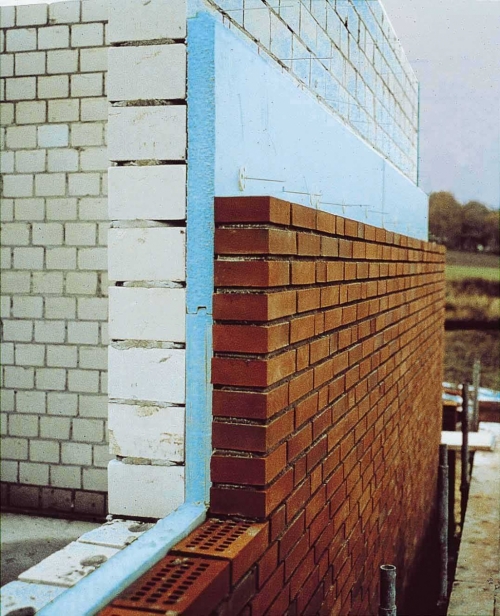
"Well" masonry represents such a cake: brick walls, insulation, facing brick. Due to the fact that it is impossible to protect the insulation from moisture in such a structure, one should choose one that does not absorb water: , vermiculite, expanded clay other. This largely depends on the facing material.
![]()
"Wet" facade It is carried out by fixing the insulation to a wall made of brick, concrete or blocks, and on top of applying a primer and decorative layer of plaster on a reinforcing mesh.
For insulation under plaster, you can use materials with a density higher than 30 kg / m3: any wool(mineral, ecowool), expanded polystyrene(Styrofoam), extruded polystyrene foam(EPS), straw, hemp, plug, seaweed... The thickness is calculated depending on the wall material and thickness, climatic zone and other indicators.
Insulation to the wall must be either glued or fixed to the dowels. A reinforcing mesh is attached on top, and plastering work is performed.

"Warm" plasters can be used as both insulation and decorative coating. They are applied directly to the wall without additional insulation. This is one of the most environmentally friendly methods of insulation - suitable for modern eco-friendly housing with "breathing" walls. It can be used to plaster facades, slopes, curved surfaces, basements and semi-basements, balconies.
How to insulate a private house from the inside
Internal insulation work consists of insulation of the roof, attic, floor and ceilings. As stated above, it is not recommended to insulate the walls from the inside. In exceptional cases, after consulting a specialist, the walls can be sheathed with cork or other natural material from the inside.
How to insulate the roof of a private house
Insulation of a pitched roof is necessary if the insulation of the attic is not sufficient, or if the attic is in use. To do this, a crate is stuffed between the rafters, to which an insulating material with a density of up to 50 kg / m3 is attached. Outside, from the side of the roof, the material must be protected from water ingress with a waterproofing film. From the inside, from the side of the room, - with a vapor barrier membrane.
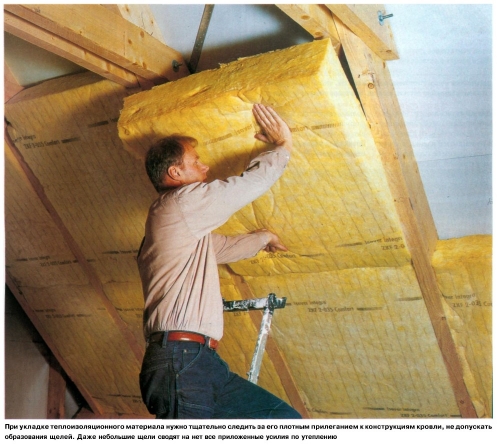
Important! The rafter structure in this type of insulation is a kind of cold bridge, since the thermal conductivity of wood is still higher than that of insulation. To eliminate this drawback, from the inside it is necessary to lay another layer of insulation in such a way as to close the rafters.
As insulation for the roof, you can use cotton wool ( mineral wool, ecowool), extruded polystyrene foam, seaweed, reeds, hemp, straw, plug and other materials. When choosing a material, please note that in the event of a leak, the cotton wool will turn into unnecessary trash. Protection of the insulation with films is necessary if the insulation layer is isolated from the room. If there is an attic with windows on the roof, no steam protection is needed.
How to insulate the attic of a private house
Since olden times, only the attic, not the roof, has been insulated in houses. And here's why: the roof was made with a gable with such an angle of inclination that snow fell well on its surface, windows were equipped in the attic that could be opened and closed depending on the need, the floor of the attic was insulated. With the onset of frost, the roof of the house was covered with a layer of snow - a natural insulation. If the temperature outside was -25 ° C, under the roof slope, i.e. in the attic, it fluctuated around 0 ° C. Insulation of the attic served to raise the temperature from 0 to 22 ° C in the living area.

If you bought an old house or are building environmentally friendly housing from natural materials, you can perform such an attic insulation: smear all the cracks in the ceiling (from the attic side) clay, sprinkle on top sand. If the clay cracks for any reason, the sand will fill the cracks. Whitewash on top or sprinkle dry slaked lime, add to this mixture spent carbide for protection from mice. Pour loose thermal insulation material on top of this: chaff from cereals, straw, sawdust, algae ladders, ecowool.
A modern way to insulate the attic: lay a vapor barrier film on the floor of the attic, sprinkle cotton wool on top with a layer of about 200 mm.
How to insulate the ceiling of a private house
It makes no sense to insulate the ceiling; rather, it may be necessary to insulate the floor between floors or the floor and the attic. How to insulate the attic floor (lower floor ceiling) has already been described above.
It is necessary to insulate the floor between floors only if the floors have different temperature conditions, i.e. the lower floor is heated, but the upper one is not, or vice versa.

In interfloor wooden floors, the insulation is placed between the logs. Can be used wadded heaters with a density of up to 50 kg / m3, hemp, ecowool... In this case, it will also serve as sound insulation.
If the floor is arranged over a floor slab, then it is necessary to use dense heat-insulating materials with a density of more than 160 kg / m3. It can be thick wadded insulation,extruded polystyrene foam, Cork.
How to insulate the floor in a private house
Insulation of the floor in a private house, made on the ground, must be started with a backfill. If the house is old, you will have to remove the flooring, logs and excavate to the required depth.
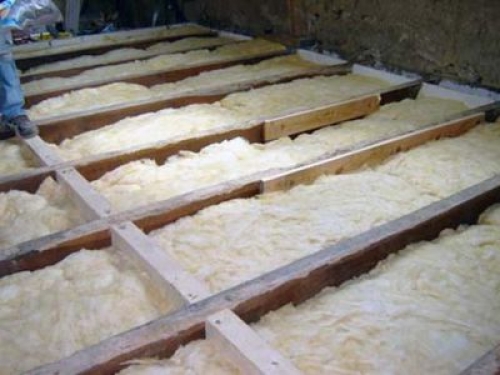
Backfilling under a wooden floor on the ground should be like this:
- Compacted soil.
- 5 - 7 cm of river sand, carefully compacted.
- 10 - 12 cm of rubble.
- Air space.
- Logs laid on house beams or support posts.
- Subfloor or waterproof plywood nailed from the bottom of the log.
- Polyethylene film for waterproofing.
- Insulation: cotton wool, hemp, seaweed, straw, Cork(loose) or others.
- Rough floor.
- Finishing floor.
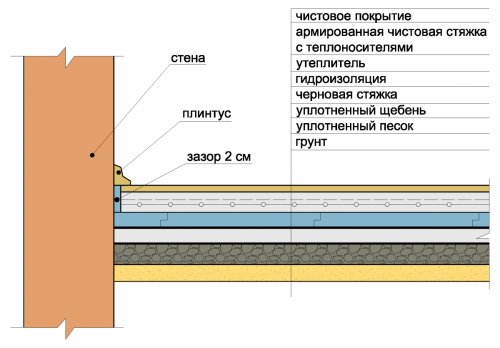
To install a concrete floor on the ground, after a layer of rubble, it is necessary to perform a rough floor screed, then lay waterproofing, the insulation layer depends on the climatic characteristics of the area, the material must be very dense (more than 160 kg / m3) in order to withstand the loads, a final screed is laid on top of the insulation and topcoat.
As insulation for concrete floor on the ground can be used extruded polystyrene foam, expanded polystyrene(Styrofoam), plug.
In conclusion, I would like to note that before insulating a private house, contact the design organizations for recommendations and calculations of insulation for your region, taking into account the material and thickness of the walls of the house. Don't try to do everything yourself. It may turn out that all the work is down the drain: the insulation will get wet from condensation, or the dew point will be in the wrong place.



